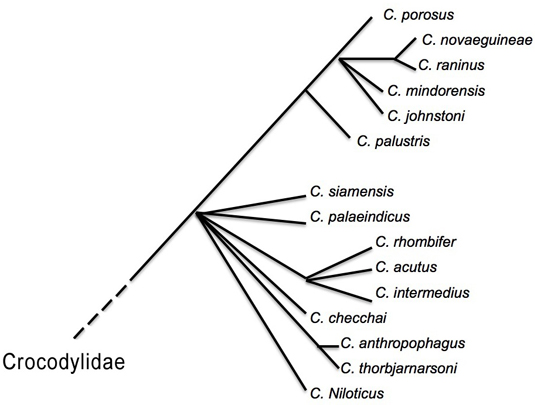Crocodylus porosus
(Saltwater Crocodile)The saltwater or estuarine crocodile (Crocodylus porosus) is the largest extant reptile[1] and the most widely distributed crocodile species. They are powerful,
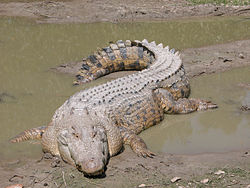 |
| Adult Crocodylus porosus (from wikipedia.org) |
highly intelligent and opportunistic predators, and are able to transition easily between bodies of fresh and salt water. Like other crocodilians they are archosaurs, and thus share a close evolutionary history (alongside birds) with non-avian dinosaurs. These animals are considered a threat to humans in many habitats where they occur, and attacks are not uncommon[2] . Though rarely seen, a population of wild C. porosus are known to inhabit Sungei Buloh Wetland Reserve (SBWR) , which places them as a contender for the title of largest predatory species in Singapore.
Table of Contents
Etymology & Vernacular
Crocodylus is derived from the Ancient Greek krokodeilos, literally "pebble worm", while the specific epithet porosus derives from the Ancient Greek porosis (callosity) combined with the Latin osus (full of), i.e., "full of callosities", in reference to the rugosity and complex structure of adult C. porosus snouts[3] .
C. porosus has many vernacular names, many specific to particular countries or regions within their vast range. Some of the better known of these reference its habitat preferences, and include the names "Saltie" (Australia), "saltwater crocodile", and "estuarine crocodile". Other names include Pukpuk (Australian Aboriginal name), and Gatta Kimbula(Sri Lanka, Sinhalese for "knotted crocodile").
Distribution and Conservation Status
 |
| Distribution of C. porosus. Map © Brandon Sidelau (permission pending) |
 C. porosus has a wide distribution around Oceania, Southeast Asia and the Indian Subcontinent, with the largest population believed to be in Australia. C. porosus' tendency towards long sea voyages
C. porosus has a wide distribution around Oceania, Southeast Asia and the Indian Subcontinent, with the largest population believed to be in Australia. C. porosus' tendency towards long sea voyages 
mean that vagrant individuals can be found far beyond their normal range. Vagrant populations have been found as far as the Maldives, Japanand Nauru. Worldwide, the IUCN lists C. porosus as "Least Concern"[4] . However, local and regional extinctions are common throughout their range. The main threat they face is the lost of fragile habitats such as mangroves.They are also sometimes killed by people for fear of attacks or because of predation on livestock. C. porosus are hunted for their meat and eggs, but their main draw is their skin. It has the highest commercial value of all crocodilian skins.
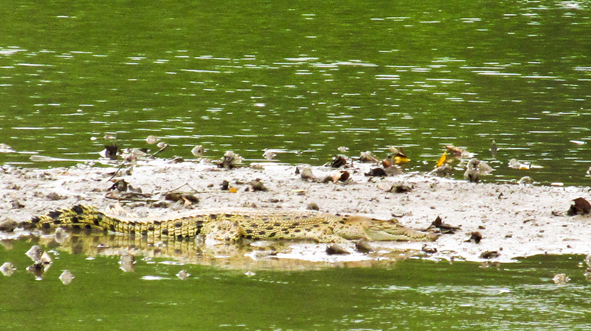 |
| C. porosus at Sungei Buloh Wetland Reserve. Photo © Henrietta Woo |
In Singapore
The IUCN lists C. porosusas extinct in Singapore, but a small population is known to reside in SBWR[5] . They have also historically been reported in many of Singapore's reservoirs, inland water bodies and estuaries. Occasional confirmed sightings occur in Lim Chu Kang and Kranji[6] . Unconfirmed reports of crocodile sightings in areas such as Sengkang, Woodlands and Pasir Ris have been reported before , but often these are simply misidentified water monitors[7] . Crocodiles are known to swim freely in the Johor Straits, and so residents may be migrants from Malaysia. There is also a possibility that the local population is comprised of escapees from Singaporean crocodile farms, though farm owners deny that they could escape at all. Regardless, the threat to the wild population of C. porosus is limited as long as SBWR is protected and intact. Some believe that the local population is in fact growing healthily.
Description & Identification
C. porosus' main identifying characteristic in adults is it's extreme size in comparison to other crocodilians and reptiles in general. Adults regularly exceed 4.5 metres in length, and the mean weight of the species is 450 kilograms.In September 2011, an individual captured in the Philippines was measured at 6.17 metres and 1075 kilograms[8] . Nicknamed Lolong, his monstrous size coupled with speculations that it may be an infamous local man-eater sparked a social media and internet frenzy, and eventually led to him becoming a captive attraction. Anectodal evidence exists for individuals greater than 7 metres in length, including a claim from 1957 of an 8.63m long individual weighing over 2000 kilograms[9] , but these remain unverified.
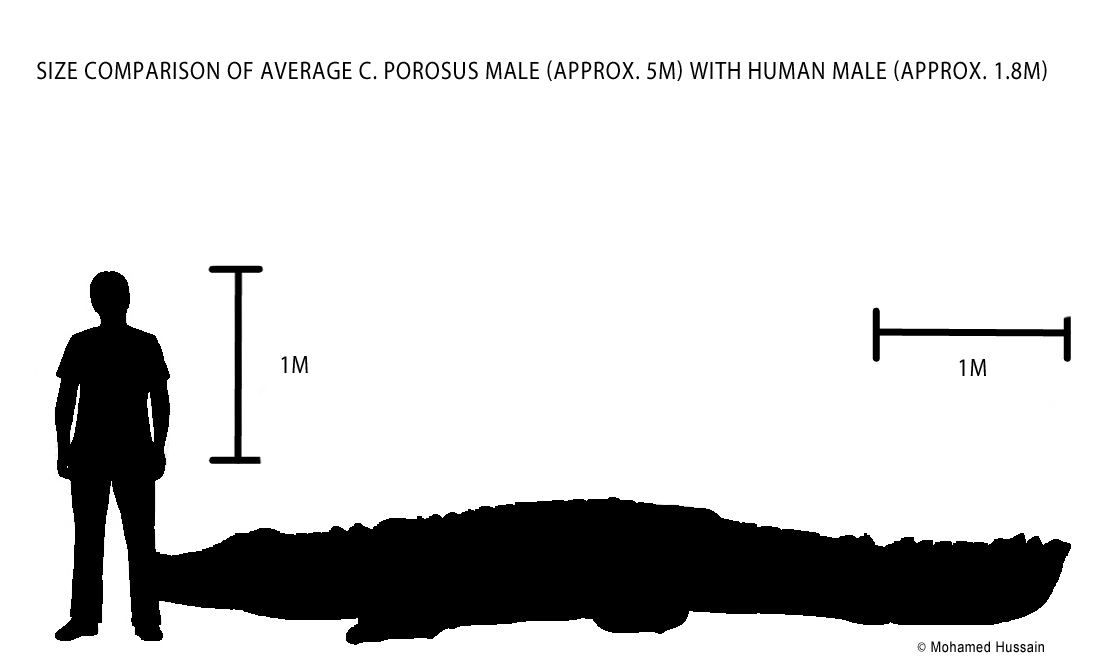 |
| Size comparison of adult male human vs. adult male C. porosus (drawn by Mohamed Hussain) |
C. porosus shows the greatest degree of sexual dimorphism amongst extant crocodilians, with males dwarfing females. Adult females typically reach lengths of 2.3 - 3.5 metres, while males usually reach 5 - 6 metres. In addition to their immense size, C. porosusare also long lived, with an approximate lifespan of 41 years in the wild[10] . They have a long broad muzzle as well as a more thick-set neck and stockier build overall as compared to other crocodiles. A distinguishing feature of males in this A distinguishing feature of males in this species is their highly rugose snout. Their eyes protrude above the rest of the skull with distinct ridges over their eye sockets. Their scales are more oval than other crocodile species, with pronounced scuted osteoderms across the dorsal surface. Juveniles are paler in colour than adults, and can be banded/spotted. Adults take on a darker colour, with an off-white ventral surface.
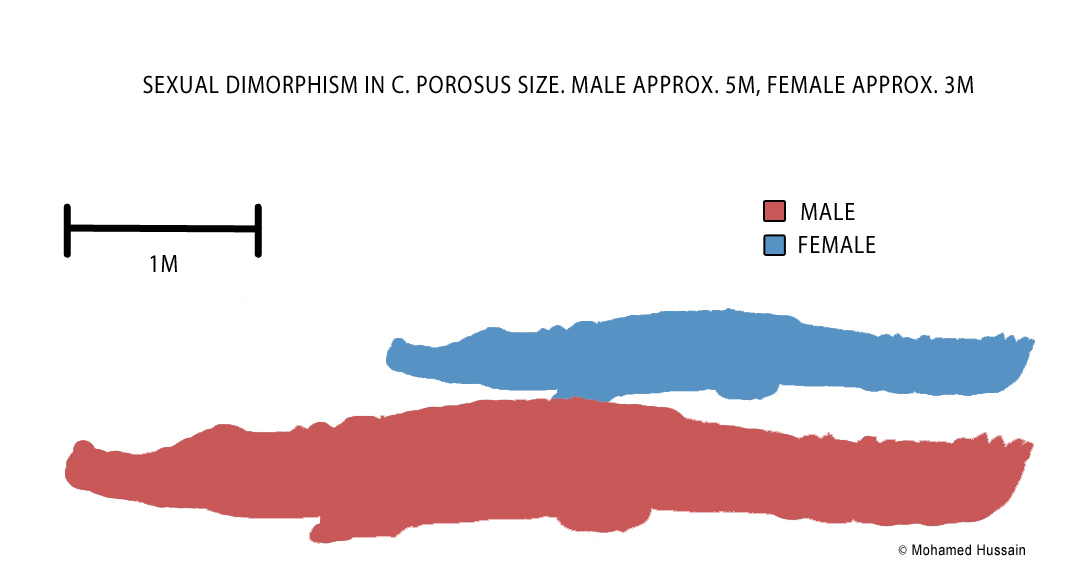 |
| Sexual dimorphism in C. porosus (drawn by Mohamed Hussain) |
C. porosus are extremely well-adapted to aquatic life.They have strong laterally compressed tails that allow them to power their streamlined bodies through the water. They have an extreme tolerance for salinity, and salt glands within their tongue to deal with excess salt intake from living in brackish marine environments. The also have webbed feet to increase their aquatic agility. As with many other Crocodylidae, they are able to generate a tremendous bite force of more than 30,000 kPa.
Behaviour
C. porosus are believed to be highly intelligent despite their brain being proportionally minuscule in comparison to their body weight. As ambush predators, they must be capable of extreme stealth and cunning in order to successfully hunt. Research has shown that they are capable of problem-solving and learning, and that they may be capable of doing so faster than mammals such as lab rats. The various calls and noises used by C. porosus hints at a possibly high degree of linguistic ability within the species[11] . Individuals use a range of barking calls to communicate with each other as well as potential threats, with different calls for mating, distress and other behavioural activities. They are thermoregulators, and can regularly be found on the banks of their resident water body basking. Due to their habit of lying motionless for extended periods of time, with minimal protrusion above the water, they can be mistaken for rotting logs. Adults of the species have no natural predators, but the young are prey to a vast variety of fish, lizards, snakes, birds, larger crocodiles of the same or different species and even tigers and other big cats. Confrontations with humans invariably result in death given their strength and size, and thus avoidance is highly advised. A large number of C. porosus are said to have killed over 400 Japanese soldiers during the Battle of Ramree Island in 1945, in what is believed to be the most devastating crocodile incident ever.
Movement
C. porosus are generally sedentary, moving minimally to conserve energy. Despite this, they are capable of considerable speed in short bursts, both on land and in water. They have been recorded at speeds of nearly 30 kilometres per hour in the water. They are able to
burst explosively from the waters' edge using propulsion from their tail, and can gallop short distances at up to 18 kilometres per hour, but many accounts of their speed on land are exaggerated. They perform death rolls as part of their predatory attack strategy, where the entire body twists about the longitudinal axis of the body to rip flesh from prey. Though usually only seen in adults when induced by tour guides, it is possible that they leap and breach the water's surface to grab aerial prey as well[12] .
Feeding
C. porosus are strict carnivores, and will take a wide variety of prey. While juveniles are only able to feed on smaller organisms such as fish, crustaceans, smaller reptiles, insects and amphibians, adults are virtually limitless in terms of what they can predate upon. C. porosus have been recorded feeding on monkeys, bats, water buffalo, sharks (including large species such as tiger sharks and white sharks), kangaroos, wild boar, turtles, livestock, horses and humans. Their preferred method of predation is via ambush. Individuals lurk unseen at the water's edge, and then burst out to grab their prey with their powerful jaws, and will then attempt to drown their prey. Their jaws have sharp peg-like teeth suited for gripping prey, and so tearing must be accomplished via "death-rolling". The jaws are capable of crushing large bovid skulls in a single bite. The impact of their initial bite is generally enough to kill prey. Smaller prey may be swallowed whole. Despite their ferocity when they attack, they are not voracious eaters, and can survive extended periods without food. This is aided partly by their predatory strategy and necessitates their generally sedentary lifestyle. C. porosus generally hunt at night, preferring to rest and bask during the day.
Reproduction
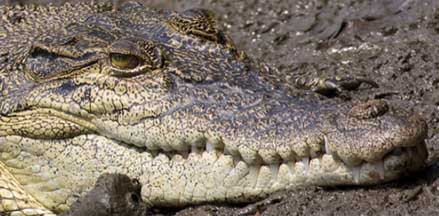 |
| C. porosus at Sungei Buloh Wetland Reserve. Photo © Brandon Chia (permission pending) |
C. porosus reaches sexual maturity at 10 - 12 years old for females and approximately 16 years old for males. Females lay eggs in vegetation mounds that a mating pair constructs early during the wet season, when tides are highest, along tidal rivers and freshwater areas. This is also their mating season. Clutches contain 40 - 60 eggs, and the mounds serve to prevent predation, insulate the eggs and elevate them from the most common course of C. porosus embryo mortality, flooding. Clutches are subject to temperature-dependant sex determination, with the highest proportion of males being born when the clutch is exposed to an ambient temperature of 31.6°C, and with the number of females increasing with both an increase as well as decrease of temperature.Incubation lasts approximately three months after which hatchlings begin to chirp underground as a signal to their mother to dig them out. The mother may gently use her mouth to aid hatching. Young C. porosus emerge at an average length of 25 - 30 centimetres, weighing in at about 70 grams. Parents have been observed to actively defend their nest and young. Post-hatching, mothers are fiercely defensive of their young,
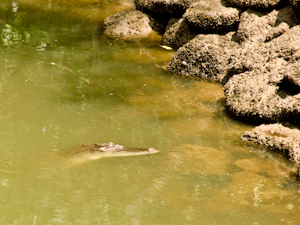 |
| C. porosus, Sungei Buloh Wetland Reserve, photo © Henrietta Woo |
maintaining a close presence and ferrying them in her mouth for months.
Habitat
As their vernacular name suggests, C. porosus do venture into marine habitats. However they fare best in freshwater and brackish water, in areas such as estuaries, marshes,billabongs and mangrove swamps. Juveniles are raised in freshwater systems with low tidal impact, but venture out further as they grow. Territorial adults will eventually marginalise them, at which point the now adolescent animals will usually move upstream into more saline waters. They may then move along the coast to other freshwater or brackish bodies or occupy offshore islands near their origins. This is particularly prevalent in areas where populations have recovered to great extents.Itinerants can be found swimming in open seas far from land.
Taxonomy
| Lineage: ›Eukaryota ---› Opisthokonta -------› Metazoa ----------› Eumetazoa -------------› Bilateria ----------------› Coelomata -------------------› Deuterostomia ----------------------› Chordata -------------------------› Craniata ----------------------------› Vertebrata -------------------------------› Gnathostomata -----------------------------------› Teleostomi --------------------------------------› Euteleostomi -----------------------------------------› Sarcopterygii ---------------------------------------------› Tetrapoda -------------------------------------------------› Amniota -----------------------------------------------------› Sauropsida --------------------------------------------------------› Sauria ------------------------------------------------------------› Archosauria ----------------------------------------------------------------› Crocodylidae --------------------------------------------------------------------› Crocodylinae ------------------------------------------------------------------------› Crocodylus |
Synonyms:
|
Phylogeny[13] :
|
Type information
The holotypefor Crocodylus porosus is stored in the British Museum of Natural History[14] in London, England. (Oopholis pondicherianus Gray, 1862). Interestingly, the currently accepted species name comes from the lectotype (Crocodilus porosus Schneider, 1801), which is stored in the Zoologisches Museum Berlin, which is part of the Museum für Naturkunde in Berlin, Germany.
- ^ Encyclopedia of Life; Facts about Salt-water Crocodile (Crocodylus porosus) - Encyclopedia of Life
- ^ Caldicott, D. G., Croser, D., Manolis, C., Webb, G., & Britton, A. (2005). Crocodile attack in Australia: an analysis of its incidence and review of the pathology and management of crocodilian attacks in general. Wilderness & Environmental Medicine, 16(3), 143-159.
- ^
Britton, A. 1995; SpeciesAccount: C. Porosus
IUCN, 2012; Crocodylus porosus (Estuarine crocodile, Salt-water crocodile)
Tan, R. 2008; Estuarine crocodile (Crocodylus porosus) on the shores of Singapore, wildsingapore
Dell’Amore, C., 2012; Giant Crocodile Breaks Size Record – Suspected in Fatal Attacks, National Geographic News
Bowler, J. K. (1977). Longevity of reptiles and amphibians in North American collections as of 1 November, 1975. Society for the Study of Amphibians and Reptiles.
University of Florida, 1996; Crocodile Communication: Crocodiles, Caimans, Alligators, Gharials. flmnh.ufl.edu
Britton, A., 1996; Crocodilian Biology Database – Locomotion (Jumping
Uetz, P. & Hallermann, J., 2012; Crocodylus porosus | The Reptile Databas
